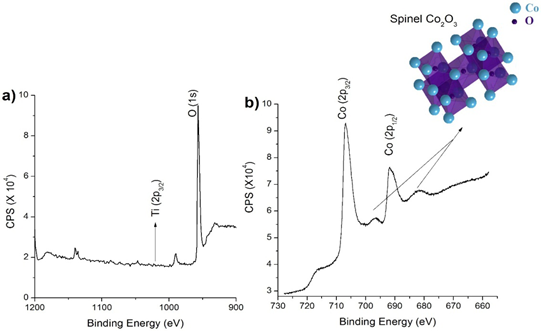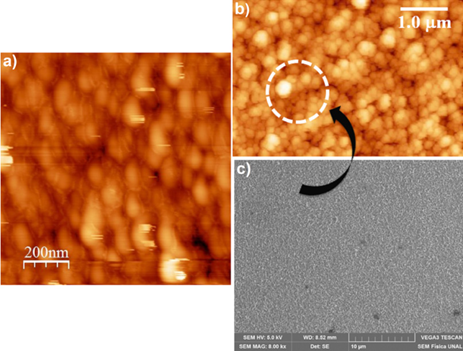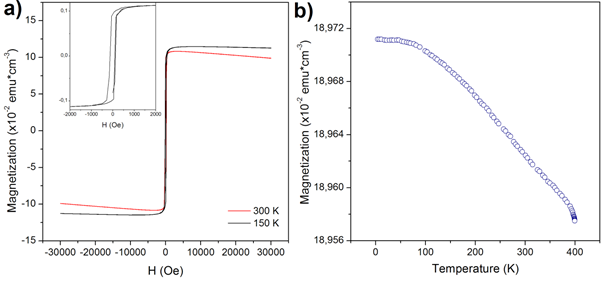1. Introduction
Titanium dioxide thin films have been the subject of numerous investigations due to its numerous potential applications and ability to form alloys with metallic compounds such as cupper (G. Charlton, et al. 2000), iron (U. Diebold, et al. 1994) or cobalt (Y. Shao, et al. 1994, C. Huang, et al. 2006). The use of different additives inside a semiconductor matrix bears a significant change in its properties, affecting aspects such as its original crystalline structure, morphology and magnetic properties. Internal oxidation of compounds during the synthesis process give insight regarding the stabilization of the mix and it is the key process for alloys to occur. The fabrication and analysis of different multicomponent oxides is therefore crucial in the enforcement of materials science and engineering.
In the several studies of the system and stability Co-Ti-O, it was established the important factor of the oxidation state in the transition metals and effect in the permeability of oxygen in the structure (Y. Xue, et al. 2005, J. Megusar, et al. 1976). However, the formation of the ternary system changes for fabrication method, synthesis parameters, and formation of the binary oxides (A. Yankin, et al. 1999, Bohuslav Brezny, et al. 1969). The study of stability in the binary oxides, cobalt titanates and oxides compounds (Co-Ti-O system) are interesting due to correlate the thermodynamic and magnetic properties of these compound (Bohuslav Brezny, et al. 1969).
This work presents the synthesis and characterization of TiO2 thin films mixed with cobalt atoms, which have been proved to useful in applications such as information storage and energy conversion from sunlight (S. Rout, et al. 2013, A. Earnshaw, et al. 1997). TiO2:Co thin films were prepared using DC Magnetron Sputtering technique and were subsequently characterized morphological, compositional and magnetically in order to fully understand the process of growth, formation of alloy compounds and magnetic behavior of the resultant samples. XPS measurements revealed the presence of a spinel-like structure for Cobalt, which was obtained after annealing processes were performed on the thin films. Said post-annealings also pertained a significant change in morphology, exhibiting larger grains distributed over the surface of the substrate. Finally, a mainly ferromagnetic behavior was found for as-deposited thin films.
2. Materials and Methods
Intermetallic alloys of cobalt mixed with TiO2 were fabricated under an argon inert atmosphere (99.999% purity) using the sputtering technique, under the DC Magnetron configuration. The work pressure inside the vacuum chamber was fixed at 2.5 x 10-2 torr, substrate temperature was established at 523 K, magnetron powers were 120 W for the TiO2 target (99.99% pure) and 75 W for the cobalt target (99.99% pure). All the thin films were deposited over soda-lime glass substrates (2.5 cm x 3 cm), which were previously cleaned in an ultrasonic bath using deionized water; the samples were then annealed in-situ at 450 °C for 2 hours. Different fabrications were carried out using different deposition times (td): 15, 30 and 45 minutes. Samples were subject to annealing processes after deposition in an oven exposed to ambient conditions at different temperatures: 723 K, 823 K and 873 K for a period of 5 h.
The thin films were structural, morphological and magnetically characterized using XPS, SEM and PPMS measurements. The structural data was acquired using a surface characterization platform XPS/ISS/UPS-ACenteno provided by SPECS (Germany), said platform is provided with a PHOIBOS 150 2D-DLD energy analyzer, monochromatic Al-Ka X-Ray radiation was used to irradiate the sample with a power of 200W, the software used to analyze the data was the CASAXPS (by Casa Software Ltd.).
Scanning electron microscopy measurements were carried out using the VEGA 3SB electron microscope equipped with a tungsten filament, data collection was made under high vacuum conditions (10-6 mbar) using an Xflash 410 m detector. Morphological characterization was complemented with Atomic Force Microscopy measurements (AFM) in tapping mode employing a (AFM ANDES).
Finally, the magnetic behavior of one of the samples was evaluated through a Physical Properties Measurement System (PPMS) using the Vibrating Sample Module (VSM) under the Zero Field Cooled (ZFC) configuration; the sample had to undergo a preliminary de-magnetization to later be brought to the measurement temperature. An additional study regarding the dependence of the magnetic moment with increasing temperature was also performed.
3. Results and Analysis
Figure 1 shows the obtained XPS spectrum for the sample fabricated with a 30 min deposition time and post-deposition annealing at 873K for 5 h. As it can be observed, titanium, oxygen and cobalt species are evident in the surface of the sample. Annealing in ambient conditions enforces the oxidation of the thin film, causing the formation of the cobalt oxide species: Co3O4. This particular compound is commonly known as a mixed-valence compound, wherein the transition element can exhibit 2 separate oxidation states simultaneously, in this case, +2 and +3.

Figure 1 a) General XPS spectrum of TiO2:Co thin films after annealing, and b) High resolution XPS spectrum of spinel cobalts. Inset of Figure b shows the spinel structure of Co2O3.
In addition to said property, the discrepancy between valences of cobalt originates a change in the crystalline structure of the compound, where consistently, two different structures are formed: A tetrahedral and an octahedral coordination. The first contains the cobalt with a +2 oxidation state among its interstices, whilst the latter bears the Co+3 ions in between its interstices; additionally, the satellite peak around 697 eV and 638 eV are associated to the formation of Co3O4 , such as spinel structure (Jeong-Min Lee, et al. 2007, Dagoberto Cabrera-German, et al. 2016). The inset of Figure 1 shows a spinel structure of Co2O3. In the case of titanium, the XPS analysis allowed the determination of the oxidation state +4 for titanium, which can be associated to the formation of TiO2.
Figure 2 and Figure 3 shows SEM and AFM micrographs of the TiO2:Co thin films with annealing process in situ and in a reactive oxygen atmosphere. An overall granular nature of the samples was evident, which was a condition present both before and after annealing at elevated temperatures (873 K). Figure 2a presents the morphological study of the sample fabricated with a 30 min deposition time and annealing in situ, in which AFM measurements allowed the determination of a root mean square roughness (RMS) of 16.73 nm, which would change to 15.68 nm after annealing at 873 K for 5 h in a reactive oxygen atmosphere (Figure 2b). This is possible to associate at increasing of grain size by nucleation due al increased annealing temperature.

Figure 2 AFM micrographs a) TiO2:Co thin film with td = 30 min with annealing process in situ, b) TiO2:Co thin film after annealing at 873 K for 5 h in ambient conditions, and c) SEM micrograph.

Figure 3 SEM micrographs of TiO2:Co thin films varying the deposition time: a) 15 min, b) 30 min, and c) 45 min.
Figure 3 shows the comparative morphological study of the samples varying the deposition time between 15 and 45 min without post-deposition annealing in a reactive oxygen atmosphere. The granular nature spread throughout the surface is more prominent for longer deposition times, bearing an increase in grain size greater than 30% associated to the nucleation and formation of the thin films (model MD for sputtering method) (Randima P. Galhenage, 2013, J. M. Albella, 2003).
Figure 4 shows the magnetic characterization of the intermetallic alloy deposited for 30 min. Figure 4a) presents the variation of the magnetic moment as a function of the applied magnetic field, measured at two separate temperatures: 150 K and 300 K. The result is a hysteresis loops for the sample analyzed at 150 K and room temperature (300 K), reaching a saturation magnetization of 11.21 x 10 -2 emu/cm3 and exhibiting a limited coercive field (Hc) of -129.5 Oe and -137.7 Oe for the 150 K and 300 K, respectively. The contrast observed with the sample studied at 300K, where the magnetization has a decreasing tendency with increasing magnetic field, points towards a diamagnetic behavior of the substrate of thin films. These behavior are associated to the weak ferromagnetic behavior (A. Tomou, et al, 2006) due to the competition between antiferromagnetic phase (Co3O4) and ferromagnetic phase (Co clusters) in the thin films.

Figure 4b shows the magnetization as a function of temperature of TiO2:Co thin film with td = 30 min and annealing in situ for a field of 0.087 Oe. It is possible to observe the saturation magnetization at low temperature (< 50 K), and the typical ferromagnetic behavior when temperature increases with Tc around 400 K.
4. Conclusion
TiO2:Co alloy thin films were fabricated using the DC Magnetron Co-Sputtering technique and were subsequently submitted to annealing processes in a reactive atmosphere. Structural characterization revealed a spinel-like crystalline structure for the cobalt oxide species present on the samples after annealing, bearing a mixed-valence compound Co3O4, along with a possible intermetallic alloy based on cobalt titanate formation. Morphological characterization revealed a preponderant granular nature of the thin films which was enforced after annealing at elevated temperatures, causing an increase in grain size, product of the formation of Co3O4 crystals. Magnetic characterization at different study temperatures showed a ferromagnetic behavior at room temperature.














